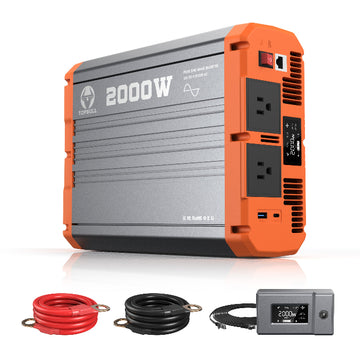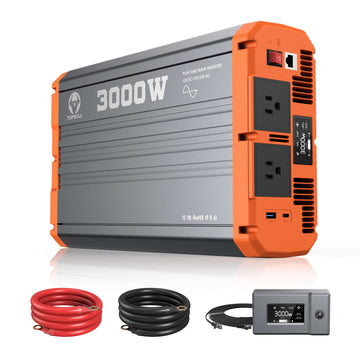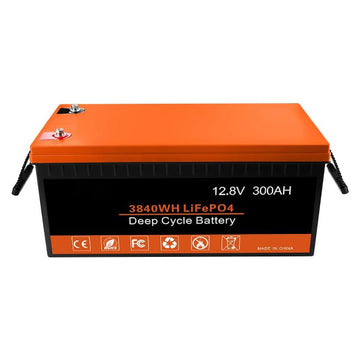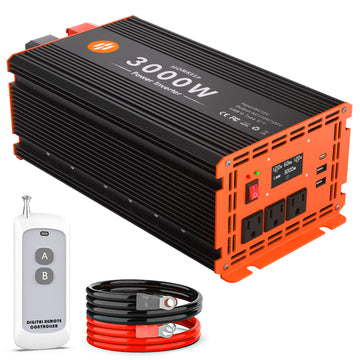Inverters can suffer from clipping when in use, and it is essential to address this issue. In this post, we'll examine inverter clipping, how it affects the power system, and how to prevent it.
What is inverter clipping?
When the battery discharge exceeds the maximum input level of the inverter, the inverter saturates, often called clipping. This situation is similar to a water pipe overflowing when overloaded; the inverter is unable to handle all the power when overloaded. Similarly, it can happen when the inverter is unable to effectively manage the flow of energy between the battery and the home or grid.
What are the effects of inverter clipping?
To some extent, inverter clipping can provide some benefits:
Easy maintenance
Clipping is a current-limiting protection mechanism that prevents the inverter and battery from being overloaded. Batteries can discharge more power than the inverter can handle, and clipping ensures that the system operates within safe limits, protecting the inverter and batteries from damage.
Improve system efficiency
In some cases, moderate clipping can improve system efficiency. It prevents the inverter from operating at low loads for long periods and reduces energy conversion losses. At the same time, inverters are most efficient when operating near high power, and moderate clipping ensures that the inverter operates in the high-efficiency range for a long time.
Extended life
By preventing overloading, clipping reduces the stress on inverters and batteries, extending their life. This is especially important in high-demand situations, such as powering a rv during peak usage periods or running a backup power system during a power outage.
In battery systems, however, the effects of inverter cancellation are more complex, and the following are its main limitations:
Transient energy loss
When using solar panels, clipping not only wastes excess solar energy but also affects the efficiency of battery charging. The hours when light is at its highest, such as midday, are also the best times to charge the battery. Wave cancellation can result in the battery not being able to fully utilize these high-power generation periods.
Increased system design complexity
The DC/AC ratio must be tightly controlled, not only by matching the solar panels to the inverter but also by taking into account the charging and discharging characteristics of the battery. If the ratio is too high, losses can occur, increasing system costs.
Increased wear
Frequent clipping can increase equipment stress and shorten battery and inverter life.
Causes of inverter clipping in battery systems
Incorrect system design
Some users mistakenly pair large-capacity batteries with inverters that are too small to take full advantage of the power. For example, a 4 kWh battery discharged at 2 kW with a 1000W inverter will show significant clipping.
Inefficient energy management
Without intelligent energy management, inverters may struggle to balance the energy flow between batteries, grids, and appliances, leading to clipping.
TOPBULL inverters have an advanced energy management system that dynamically adjusts power output according to demand and prevents clipping.
Equipment compatibility issues
Not all inverters support seamless integration with the battery system, which can lead to increased clipping issues. With lower-capacity batteries, clipping can cause the battery to fill up quickly, further exacerbating energy waste.
How to avoid inverter clipping in battery systems
Choosing the right size inverter
The inverter's power should match the battery's maximum sustainable discharge power. For example, if the battery's power is 2000 W, choose an inverter with a capacity of at least 2000W. TOPBULL offers high-quality inverters from 2000 to 4000 W to suit all types of batteries.
Choosing a high-efficiency inverter
High-efficiency inverters minimize energy loss during conversion. Our inverters are up to 98% efficient, ensuring that more of your battery's energy is used.
Regular maintenance and monitoring
Regularly check the operating status of the inverter and batteries, and update the inverter firmware promptly to ensure that the equipment is operating at optimal levels.
Ready to eliminate inverter clipping?
In a solar power system, clipping not only results in wasted energy, it can also limit the energy storage potential of the battery and reduce the overall efficiency of the system. But with the advanced technology and intelligent design of our inverters, you can minimize clipping and get the most out of your batteries and solar panels.
Our user John is a typical success story. He used a 4000W inverter with 4kW solar panels and a 10kWh battery to build a highly efficient home solar system. Initially, John's system suffered from frequent midday shutdowns, losing up to 5% of its annual output. This not only wastes valuable solar resources but also limits the energy storage capacity of the battery.
To solve this problem, John upgraded to the TOPBULL 4000W inverter, which features Dynamic MPPT technology and an intelligent Energy Management System (EMS). Dynamic MPPT technology adjusts the output voltage and current of the solar panels in real time to ensure efficient power generation even during the hours of the strongest light. Meanwhile, the intelligent EMS dynamically distributes energy flow based on the battery state of charge and load demand to avoid wasting excess power.

As a result of the optimization, John's system clipping loss was reduced from 5% to 1.5%, and his annual energy production increased by 18%. Now his batteries can store more power during the day and provide stable power for the whole family at night. John said, "The TOPBULL inverter not only solved the clipping problem but also made my solar system smarter and more efficient!
Take action now to save your energy today
👉🏻Get more savings on your TOBULL Inverter order now!
- Dynamic MPPT technology: Reduces clipping losses and improves power generation efficiency.
- Intelligent EMS integration: Optimizes energy flow and maximizes battery storage potential.
- High compatibility: Adapts to a wide range of solar panels and battery types to meet future expansion needs.
- Reliable performance: High-quality components are used to ensure long-term stable operation.














